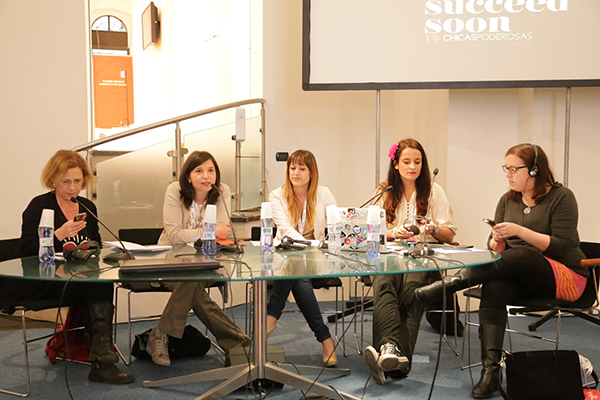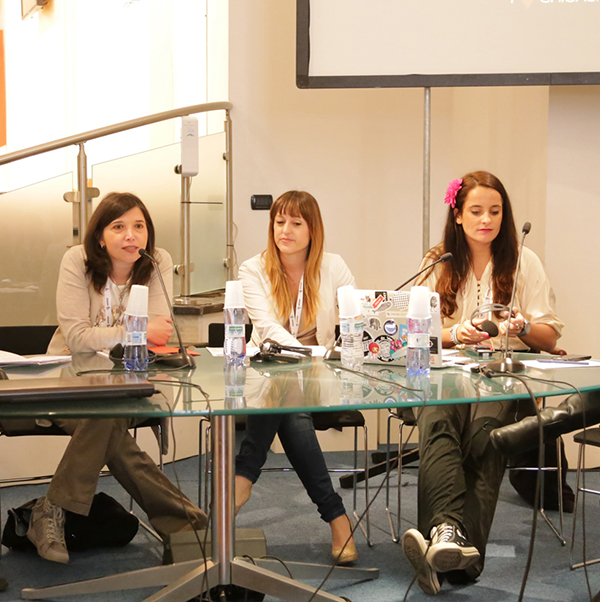
photo by Danila D’Amico
Lucy Marcus has a simple trick to identify sexism: “When you don’t know if you are being sexist, just try substituting the word men for women and see how it sounds.”
Not just one, but actually two panels at #ijf14 deal with the issue of women in journalism, one specifically about tech journalism, and one more generally about women in journalism. Different panels, different moderators, different languages even, and yet the very same issues emerged.
Feeling of inadequacy, instances of sexism, importance of mentorship, are trans-newsroom and trans-national issues facing women in journalism. While these issues are not unique to women working in journalism, they pertain particularly to the media industry: as the study on the State of Women in the US Media published last February showed, there is actually a small decrease in female presence in the newsrooms since 1999 despite a growing number of women studying journalism.
Uncomfortable with being singled out
Opening up the panels, a few women in both panels (Lucy Marcus, Jo Webster, Jillian York, Barbara Sgarzi) took time to note that they were hesitant in participating in a female panel about women. “I don’t like to be singled out, I want to be recognised as someone who does a bloody good job,” said Webster, expressing a common feeling between her colleagues, who nodded in agreement. “But then,” she continued, “I went to an event about technology. Most of the audience were women, but all the speakers in the panels were male.” Echoeing her, York also admits recognising the value in discussing women’s position in journalism, even in an all female panel, after attending the infamous Google event with all men panels, which sparked a debate precisely regarding discrimination of women in tech environments.
This is an issue Mariana Santos lived on her skin. When her team leader and mentor decided to leave The Guardian interactive team, she applied for his position feeling she was the perfect candidate: she was competent, hard-working, and knew the team well. Just a few hours after sending in the application, she received an email denying her the job – or even an interview. Her boss’ replacement turned out to be an older, white man who had been working in the paper for a long time, but never in digital or interactive. So she left, as did a few of her colleagues. Santos is now at the end of her Knight International Journalism Fellowship in which she ran a mentorship programme called Chicas Poderosas (Powerful Women) to inspire more women in Latin America to become involved with tech journalism. Having a mentor is crucial in the beginning phase of a career, she said.
External support is needed as women do not “sell themselves” as well as men, due to feelings of inadequacy, underestimating their skills – and they are often made to feel that way. “It’s like we are never good enough,” sighted Sgarzi. Women themselves have to support each other, and hold each other into account, said Marcus: “When I am invited to a panel about women at a conference, I first check if that is the only panel with women. If it is, I decline the invitation. In general, I check how many female panelists there are and if they are not enough, I tell them: ‘I have binders full of women!’ It’s important to hold both ourselves and media organisations to account.”
Value of diversity
York has a theory on why women are such a minority in the tech world and in the newsrooms: “Women are seen as a bad cultural fit because men fear they will have to give up the dick jokes,” she said, only half jokingly. “So many women do not get promoted, and are not made feel included or part of the team.”
The lack of women in high positions affects news coverage, too. Margaret Sullivan, Public Editor at the New York Times, said it is “absurd” to aim at an equal representation of female sources in every story, because sometimes it just happens that the right people to talk to are men, because of the position they hold. Yet, it is important to strive for women in more powerful position because “they make different kind of decisions,” continued Sullivan. Diversity at all levels of media, reminded Webster, leads to more newsgathering and story telling, ultimately producing a better story whereas: “Right now, we see the world from a very limited perspective.”
These issues show why panels focusing on women in journalism are still sadly necessary. Still, the message is clear: women are tired to be seen as an issue. They demand to be appreciated as a resource instead.


